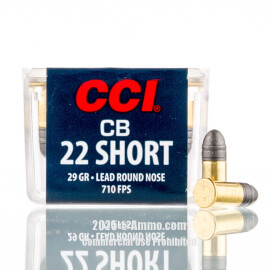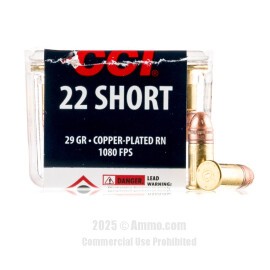
22 Short Ammo For Sale
Overview of 22 Short Ammo
Introduced as the first American metallic cartridge ever produced in 1857, the .22 Short was an entirely self-contained cartridge that was moisture-resistant and more quickly reloaded than other firearms of the era. It was a rimfire cartridge, meaning that the priming compound was applied inside the rim of the cartridge, which ignited the powder charge held in the case. Smith & Wesson's first revolver was chambered for the .22 Short, which was designed to be used as a self-defense cartridge – a popular use for soldiers in the Civil War. The .22 Short remained popular after the war and was chambered in a growing variety of rifles and small pistols. Many youngsters of the late 19th century and early to mid 20th century received .22 Short rifles as their first gun. While it was eventually replaced by the more popular .22 LR, there are still dedicated fans who have kept the place of this cartridge secure in the world of shooting.
The original .22 Shorts carried black powder, and the old Smith & Wesson Model 1 revolvers that shot them often suffered from pitting. In the smokeless powder era, the 29 grain (gr) bullet provided some serious speed and power for this little round. Make it into a hollow point and you have a seriously deadly and accurate round for shooting small game at short range. It’s relatively quiet, making it an excellent choice for guys sitting around their backyard plinking on a Saturday night. This likewise means it’s an effective round for hunters who want to maintain a bit of stealth.
22 Short Ballistics: Chart of Average 22 Short Ballistics
Note: This information comes from the manufacturer and is for informational purposes only. The actual ballistics obtained with your firearm can vary considerably from the advertised ballistics. Also, ballistics can vary from lot to lot with the same brand and type load.
| 22 Short Bullet WEIGHT | Muzzle VELOCITY (fps) 22-1/2" Bbl. | Muzzle ENERGY (ft. lbs.) 22-1/2" Bbl. | Mid-Range TRAJECTORY (in.) | Muzzle Velocity | ||
|---|---|---|---|---|---|---|
| Muzzle | 100 yds. | Muzzle | 100 yds. | 100 yds. | 6" Bbl. | |
| 27 Grain HP | 1164 | 920 | 81 | 50 | 4.3 | 1077 |
| 29 Grain CB | 727 | 610 | 33 | 24 | n/a | 706 |
| 29 Grain Target | 830 | 695 | 44 | 31 | 6.8 | 786 |
Customer Reviews
-
bobby said:
ammo hard to find
-
Steven said:
Great ammo. For High Standard Olympic competition shooters, this is what you want. Sometimes hard to come by! Ammo.com always comes through.
-
Yoshibare said:
I highly recommend this ammo for any scenario or circumstances
-
SKY said:
Products performs well.
-
Billy said:
I only want or will purchase this CCI product for my needs. Have tried other brands and they fail, might as well throw rocks. Live in a semi populated area and need to use 22 shorts to thin the squirrel population in my yard. This product gets the job done.
-
JR said:
The service was great, 22 shorts are difficult to find. No complaints at all
-
BlackBear87 said:
Have bought this ammo many times and am glad I did one of the most reliable rounds an feel like I got a great deal
-
Lisa A said:
Glad to find these, fast easy shipping (even to Illinois the communist state ).





















